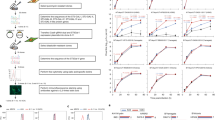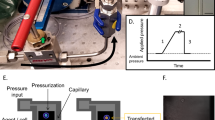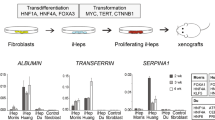Abstract
Primary cultures of human embryonic kidney (HEK) cells exhibit an in vitro life span of approximately 15 to 20 generations. We report here that transfection of HEK cells with the early gene region of the SV40 DNA tumor virus results in a five-fold increase in cell life span. These cells with extended life span were morphologically similar to normal HEK cells, retained their attachment-dependence for growth and ceased growth at confluence. After 70 to 90 generations in vitro, the transfected cells entered a crisis period, marked by continued basal metabolism in the absence of cell division. Two human kidney cell lines of indefinite life span were isolated from clonal populations of these transfected cells in crisis. These “immortal” HEK cells also demonstrated relatively little evidence of oncogenic transformation, although their morphology and growth characteristics did differ somewhat from the primary HEK cells and the HEK cells with extended life span.
This is a preview of subscription content, access via your institution
Access options
Subscribe to this journal
Receive 12 print issues and online access
$209.00 per year
only $17.42 per issue
Buy this article
- Purchase on Springer Link
- Instant access to full article PDF
Prices may be subject to local taxes which are calculated during checkout
Similar content being viewed by others
References
Hayflick, L. 1965. The limited in-vitro life span of human diploid cell strains. Exp. Cell Res. 37:614–636.
Hayflick, L. 1979. The cellular basics for biological aging, p. 159–186. In: Handbook of the Biology of Aging. C. E. Finch and L. Hayflick (Eds.). Von Nostrand Reinhold.
Lin, M.C., Shay-Whey, M.K., Dykman, D.D., Beckner, S.K. and Shih, T.Y. 1982. Loss and restoration of glucagon receptors and responsiveness in a transformed kidney cell line. Exp. Cell Res. 142:181–189.
Cherington, V., Brown, M., Paucha, E., St. Loius, J., Speigelman, B.M. and Roberts, T.M. 1988. Separation of simian virus 40 large-T-antigen transforming and origin-binding functions from their ability to block differentiation. Mol. Cell Biol. 8:1380–1384.
Yamashita, K., Hitoi, A., Taniguchi, N., Yokosawa, N., Tsukada, Y. and Kobata, A. 1983. Comparative study of the sugar chains of γ-glutamyltranspeptidases purified from rat liver and rat AH-66 hepatoma cells. Cancer Res. 43:5059–5063.
Land, H., Parada, L.F. and Weinberg, R.A. 1983. Tumorigenic conversion of primary embryo fibroblasts requires at least two cooperating oncogenes. Nature 304:596–602.
Ruley, H.E. 1983. Adenovirus early region 1A enables viral and cellular transforming genes to transform primary cells in culture. Nature 304:602–606.
Oshimur, M., Gilmer, T.M. and Barrett, J.C. 1985. Nonrandom loss of chromosome 15 in Syrian hamster tumors by v-Ha-ras plus v-myc oncogenes. Nature 316:636–639.
Bishop, J.M. 1987. The molecular genetics of cancer. Science 235:305–311.
Müeller, R. and Wagner, E.F. 1984. Differentiation of F9 teratocarcinoma stem cells after transfer of c-fos proto oncogenes. Nature 311:438–442.
Holt, J.T., Redner, R.L. and Neinhuis, A. 1988. An oligomer complementary to c-myc mRNA inhibits proliferation of HL-60 pro-myelocytic cells and induces differentiation. Mol. Cell. Biol. 8:963–973.
DeCaprio, J.A., Ludlow, J.W., Frigge, J., Shew, J.Y., Huang, C.-M., Lee, W.-H., Marsiho, E., Paucha, E. and Livingston, D.M. 1988. SV40 large tumor antigen forms a specific complex with the product of the retinoblastoma susceptibility gene. Cell 54:275–283.
Ludlow, J.W., DeCaprio, J.A., Huang, G-M., Lee, W-H., Paucha, E., and Livingston, D.M. 1989. SV40 large T antigen binds preferentially to an underphosphorylated member of the retinoblastoma susceptibility gene product family. Cell 56:57–65.
Whyte, P., Williamson, N.M. and Harlow, E. 1989. Cellular targets for transformation by the adenovirus E1A proteins. Cell 56:67–75.
Weinberg, R.A. 1985. The action of oncogenes in the cytoplasm and nucleus. Science 230:770–776.
Nicholaiew, N. and Dautry, F. 1986. Growth stimulation of rat primary embryo fibroblasts by the human myc gene. Exp. Cell Res. 166:357–369.
Curran, T., Miller, A.D., Zokas, L. and Verma, I.M. 1984. Viral and cellular fos proteins: A comparative analysis. Cell 36:259–268.
Houweling, A., Van Den Elsen, P.J. and Van Der Eb, A.J. 1980. Partial transformation of primary rat cells by the leftmost 4.5% fragment of adenovirus 5 DNA. Virology 105:537–550.
Roussoulzadegan, M., Cowie, A., Carr, A., Glaichenhaus, N., Kamen, R. and Cuzin, F. 1982. The roles of individual polyoma virus early proteins in oncogenic transformation. Nature 300:713–718.
Stacey, D.W. and Rung, H.-F. 1984. Transformation of NIH 3T3 cells by microinjection of Ha-ras p21 protein. Nature 310:508–511.
Livingston, D.M. and Bradley, M.K. 1987. The simian virus 40 large T antigen: A lot packed into a little. Mol. Biol. Med. 4:63–80.
Bikel, I., Montano, X., Agha, M.E., Brown, M., McCormack, M., Boltax, J. and Livingston, D.M. 1987. SV40 small t antigen enhances the transformation activity of limiting concentrations of SV40 large t antigen. Cell 48:321–330.
Choi, Y., Lee, I. and Ross, S.R. 1988. Requirement for simian virus 40 small tumor antigen in tumorigenesis in transgenic mice. Mol. Cell. Biol. 8:3382–3390.
Sack, G.H. Jr., 1981. Human cell transformation by simian virus 40: A review. In Vitro 17:1–19.
Chang, S.E. 1986. In-vitro transformation of human epithelial cells. Biochim. Biophys Acta 823:161–194.
Chang, L.-S., Pater, M.M., Hutchinson, N.I. and DiMayorca, G. 1984. Transformation by purified early genes of simian virus 40. Virology 133:341–353.
Gorman, C., Padmanabhan, R. and Howard, B.H. 1983. High efficiency DNA-mediated transformation of primate cells. Science 221:551–553.
Gorman, C.M., Marlino, G.T., Willingham, M.C., Pastan, I. and Howard, B.H. 1982. The rous sarcoma virus long terminal repeat is a strong promoter when introduced into a variety of eukaryotic cells by DNA-mediated transfection. Proc. Natl. Acad. Sci. USA 79:6777–6781.
Graham, F.L., Smiley, J., Russell, W.C. and Nairn, R. 1977. Characteristics of a human cell line transformed by DNA from human adenovirus type 5. J. Gen. Virol. 36:59–72.
Taub, M. and Sato, G. 1980. Growth of functional primary cultures of kidney epithelial cells in denned medium. J. Cell. Physiology 105:369–378.
Shein, H.M. and Enders, J.F. 1962. Multiplication and cytopathogenicity of simian vacuolating virus 40 in cultures of human tissues. Proc. Soc. Exp. Biol. and Med. 109:495–500.
Major, E.O. and Matsumura, P. 1984. Human embryonic kidney cells: stable transformation with an origin-defective simian virus 40 DNA and use as hosts for human papovavirus replication. Mol. Cell. Biol. 4:379–382.
Chang, L.-S., Pan, S., Pater, M.M. and DiMayorca, G. 1985. Differential requirement for SV40 early genes in immortalization and transformation of primary rat and human embryonic kidney cells. Virology 146:246–261.
Osborn, M. and Weber, K. 1975. Simian virus 40 gene A function and maintenance of t transformation. J. Virol. 15:636–644.
Petit, C.A., Gardes, M. and Feutemn, J. 1983. Immortalization of rodent embryo fibroblasts by SV40 is maintained by the A gene. Virology 127:74–82.
Gotoh, S., Gelb, L. and Schlessinger, D. 1979. SV40-transformed human diploid cells that remain transformed throughout their limited lifespan. J. Gen. Virol. 42:409–414.
Pereira-Smith, O.M. and Smith, J.R. 1981. Expression of SV40 T antigen in finite lifespan hybrids of normal and SV40-transformed fibroblasts. Som. Cell Gen. 7:411–412.
Pereira-Smith, O.M. and Smith, J.R. 1987. Functional simian virus 40 T antigen is expressed in hybrid cells having finite proliferative potential. Mol. Cell. Biol. 7:1541–1544.
Levitt, A., Chen, S., Blanck, G. and Pollack, R.E. 1985. Two integrated partial repeats of simian virus 40 together code for a super-T antigen. Mol. Cell. Biol. 5:742–750.
May, E., Jeltsch, J.-M. and Gannon, F. 1981. Characterization of a gene encoding a 115K super T antigen expressed by a SV40-transformed rat cell line. Nuc. Acids Res. 9:4111–4129.
Clayton, C.E., Lovett, M. and Rigby, P.W.J. 1982. Functional analysis of a simian virus 40 super T antigen. J. Virol. 44:974–982.
Butel, J.S., Wong, C. and Evans, B.K. 1986. Fluctuation of simian virus 40 (SV40) super T-antigen expression in tumors induced by SV40-transformed mouse mammary epithelial cells. J. Virol. 60:817–821.
Chen, S., Verderame, M., Lo, A. and Pollack, R. 1981. Nonlytic simian virus 40-specific 100K phosphoprotein is associated with anchorage-independent growth in simian virus 40-transformed and revertant mouse cell lines. Mol. Cell. Biol. 1:994–1006.
Reich, N.C., Oren, M. and Levine, A.J. 1983. Two distinct mechanisms regulate the levels of a cellular tumor antigen, p53. Mol. Cell. Biol. 3:2143–2150.
Rubin, H., Figge, J., Bladon, M.T., Chen, L.B., Ellman, M., Bikel, I., Farrell, M., and Livingston, D.M. 1982. Role of small t antigen in the acute transforming activity of SV40. Cell 20:469–480.
Bikel, I., Mamon, H., Brown, E.L., Boltax, J., Agha, M. and Livingston, D.M. 1986. The t-unique coding domain is important to the transformation maintenance function of the simian virus 40 small t antigen. Mol. Cell. Biol. 6:1172–1178.
Ponten, J. 1985. Lifespan and “immortalization” of mammalian cells. Anticancer Res. 5:387–391.
Jat, P.S. and Sharp, P.A. 1986. Large T antigens of simian virus 40 and polyomavirus efficiently establish primary fibroblasts. J. Virol. 59:746–750.
Asselin, C. and Bastin, M. 1985. Sequences from polyomavirus and simian virus 40 large T genes capable of immortalizing primary rat embryo fibroblasts. J. Virol. 56:958–968.
Girardi, A.J., Jensen, F.C. and Koprowski, H. 1965. SV40-induced transformation of human diploid cells: Crisis and recovery. J. Cell. Comp. Physiol. 65:69–84.
Zouzias, D., Jha, K.K., Basilico, C. and Ozar, H.L. 1980. Human fibroblasts transformed by the early region of SV40 DNA: analysis of “free” viral DNA sequences. Virology 104:439–453.
Periera-Smith, O.M. and Smith, J.R. 1983. Evidence for the recessive nature of cellular immortality. Science 221:964–966.
Neufeld, D.S., Ripley, S., Henderson, A. and Ozar, H.L. 1987. Immortalization of human fibroblasts transformed by origin-defective simian virus 40. Mol. Cell. Biol. 6:2794–2802.
Van der Eb, A.J. and Graham, F.L. 1980. Assay for transforming activity of tumor virus DNAs. Methods Enzymol. 65:826–839.
Bouck, N. and DiMayorca, G. 1979. Evaluation of chemical carcinogenicity by in vitro neoplastic transformation. Meth. Enzymol. 58:296–302.
Graham, R.C. and Karnovsky, M.J. 1965. The early stages of absorption of injected horsradish peroxidase in the proximal tubules of mouse kidney: ultrastructural cytochemistry by a new technique. J. Histochem. Cytochem. 14:291–302.
Smith, P.K. et al. 1985. Measurement of protein using bicinchoninic acid. Anal. Chem. 105:76–85.
Hinson, D.L. and Webber, R.J. 1988. Miniaturization of the BCA protein assay. Biotechniques 6:14–16.
Laemmli, U.K. 1970. Cleavage of structural proteins during the assembly of the head of the bacteriophage T4. Nature 227:680–685.
Burnette, W.H. 1981. Western blotting: Electrophoretic transfer of proteins from SDS-polyacrylamide gels to unmodified nitrocellulose and radiographic detection with antibody and with radioiodinated protein A. Anal. Biochem. 112:195–203.
Author information
Authors and Affiliations
Rights and permissions
About this article
Cite this article
Abcouwer, S., Robinson, P., Goochee, C. et al. Generation of Human Embryonic Kidney Cells with Extended In Vitro Life Span through Viral Oncogene Transfection. Nat Biotechnol 7, 939–946 (1989). https://doi.org/10.1038/nbt0989-939
Received:
Accepted:
Issue Date:
DOI: https://doi.org/10.1038/nbt0989-939



